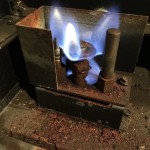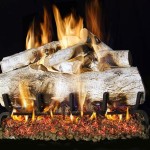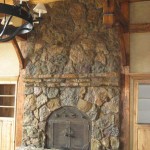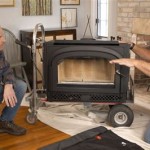Why Does My Fireplace Have Vents On The Side?
Many homeowners with traditional fireplaces discover openings or vents located on the sides or sometimes above the firebox. These vents, often mistaken for flaws in the fireplace design, serve a crucial purpose in enhancing the fireplace's efficiency and functionality. Understanding why these vents exist provides valuable insight into the mechanics of heat circulation and combustion within a fireplace system. Ignoring or improperly managing these vents can potentially compromise the fireplace's performance and even safety.
The presence of side vents in a fireplace generally indicates that it is a heat-circulating fireplace. These fireplaces are designed to improve heating efficiency compared to traditional, non-circulating fireplaces. A traditional fireplace operates primarily by radiant heat, directly warming objects and people in front of the firebox. A significant portion of the heat generated is lost up the chimney, offering minimal contribution to heating the surrounding room or house. A heat-circulating fireplace aims to mitigate this heat loss and distribute warmth more effectively.
The vents are integral to this heat-circulating design. They are connected to a system of metal ducts or chambers that surround the firebox. Cool air enters the lower vents, is heated within these chambers, and then exits through the upper vents, effectively creating a convection current. This distributes warmed air into the room. This method of heating relies on the natural properties of hot air, which rises, and cold air, which sinks, to establish a continuous cycle of air movement. The design specifically leverages these principles to more efficiently transfer heat from the fire to the living space.
The specific configuration and placement of these vents can vary depending on the fireplace model and manufacturer. Some fireplaces feature vents only on the sides, while others incorporate them above the firebox. The shape and size of the vents may also differ, reflecting variations in the design and intended airflow. Despite these differences, the underlying principle remains the same: to facilitate the circulation of heated air and improve overall heating efficiency.
It is important to note that the effectiveness of a heat-circulating fireplace can be influenced by several factors, including the size of the fire, the type of wood burned, and the proper functioning of the venting system. Obstructions within the vents or the surrounding chambers can impede airflow and reduce heating efficiency. Regular maintenance, including cleaning the vents and inspecting the ductwork, is essential to ensure optimal performance.
Improving Heating Efficiency
The primary purpose of side vents on a fireplace is to significantly improve its heating efficiency. Traditional fireplaces are notoriously inefficient, with a large percentage of the heat produced escaping up the chimney. Heat-circulating fireplaces, equipped with side vents and a heat exchanger system, aim to recapture some of this lost heat and redirect it back into the room.
The process begins with cool air entering the lower vents. This air is drawn into a network of metal channels or chambers that surround the firebox. As the fire burns, these metal surfaces heat up, transferring heat to the cool air circulating within the chambers. The heated air, now lighter and less dense, rises naturally and exits through the upper vents. This creates a continuous cycle of air circulation, drawing in cool air, heating it, and expelling it back into the room. This convection process is significantly more efficient at distributing heat than relying solely on radiant heat.
The effectiveness of this system depends on several factors. The size and design of the heat exchanger are crucial, as a larger surface area allows for greater heat transfer. The airflow through the vents must also be optimized, ensuring that cool air can enter and heated air can exit freely. Any obstructions, such as dust, debris, or improperly installed components, can impede airflow and reduce heating efficiency. Furthermore, the size of the fire and the type of wood burned can influence the amount of heat produced and the overall performance of the system.
Homeowners can further enhance the efficiency of a heat-circulating fireplace by taking certain steps. Regularly cleaning the vents and the surrounding area will ensure unobstructed airflow. Using seasoned hardwood, which burns hotter and longer than softwood, will maximize heat output. Properly managing the fire, ensuring adequate airflow and fuel, will also contribute to improved efficiency. Some homeowners also consider installing a fireplace insert, which is a self-contained unit designed to fit inside an existing fireplace, further enhancing its heating capabilities.
Understanding Fireplace Mechanics
The presence of side vents highlights the complex mechanics involved in fireplace operation. A fireplace is not simply a decorative feature; it is a system designed to safely contain and manage combustion while providing heat. The side vents are integral to maintaining this balance, contributing to both heating efficiency and proper airflow within the fireplace system.
The firebox, the central component of the fireplace, is designed to contain the fire and withstand high temperatures. The chimney, connected to the firebox, provides a pathway for the exhaust gases to escape. The damper, a movable plate within the chimney, regulates airflow and prevents heat loss when the fireplace is not in use. The side vents, in a heat-circulating fireplace, add another layer of complexity to this system.
The vents are connected to a network of air chambers that surround the firebox. These chambers act as a heat exchanger, transferring heat from the firebox to the circulating air. The placement and design of the vents are carefully engineered to create a natural convection current, drawing in cool air from the bottom and expelling heated air from the top. This process relies on the principles of thermodynamics, specifically the relationship between temperature, density, and airflow.
Understanding these mechanics is crucial for homeowners to operate their fireplaces safely and efficiently. Improper use, such as burning inappropriate materials or neglecting maintenance, can compromise the fireplace's performance and potentially create hazardous conditions. For example, burning wet or unseasoned wood can produce excessive smoke and creosote buildup, increasing the risk of chimney fires. Blocking the vents can restrict airflow and reduce heating efficiency. Regular inspection and cleaning are essential to ensure that all components of the fireplace system are functioning properly.
Furthermore, understanding the mechanics of a heat-circulating fireplace can inform decisions about fireplace upgrades and modifications. Homeowners may consider installing a fireplace insert to further enhance heating efficiency or adding a blower to circulate air more forcefully. However, any modifications should be carefully considered and performed by qualified professionals to ensure that they do not compromise the safety or functionality of the fireplace system.
Safety Considerations and Best Practices
While side vents contribute to improved heating efficiency, safety remains a paramount concern when operating any fireplace. Improper use or neglect of maintenance can lead to hazardous situations, including chimney fires, carbon monoxide poisoning, and structural damage. Understanding the safety implications of side vents and adopting best practices for fireplace operation is crucial for homeowners.
One key safety consideration is ensuring that the vents are never blocked or obstructed. Blocking the vents can restrict airflow, causing the fireplace to overheat and potentially damaging surrounding materials. It can also lead to incomplete combustion, increasing the production of carbon monoxide, a colorless and odorless gas that can be fatal. Homeowners should regularly inspect the vents to ensure that they are clear of dust, debris, and any other obstructions.
Another important safety practice is to burn only seasoned hardwood. Softwood and unseasoned wood contain higher moisture content, which can produce excessive smoke and creosote buildup in the chimney. Creosote is a highly flammable substance that can ignite and cause a chimney fire. Seasoned hardwood burns hotter and cleaner, reducing the risk of creosote buildup and improving overall fireplace efficiency.
Regular chimney inspections and cleaning are also essential for fireplace safety. A qualified chimney sweep can inspect the chimney for cracks, obstructions, and creosote buildup, and can clean the chimney to remove any accumulated debris. It is generally recommended to have a chimney inspection at least once a year, and more frequently if the fireplace is used regularly. The National Fire Protection Association (NFPA) provides guidelines for chimney inspection and cleaning, which homeowners should follow.
Finally, it is crucial to install and maintain working carbon monoxide detectors in the home. Carbon monoxide poisoning can occur even with a properly functioning fireplace, so detectors provide an important layer of safety. Detectors should be placed on each level of the home, especially near sleeping areas, and should be tested regularly to ensure that they are working properly. Batteries should be replaced at least once a year, or as recommended by the manufacturer.
What Is This Vent Above My Firebox Hearth Com Forums Home
Remove Or Cover Up Old Heatilator Vents Hearth Com Forums Home

Vented Vs B Vent Direct Free Dixie S
Remove Or Cover Up Old Heatilator Vents Hearth Com Forums Home
Gas Fireplace Venting Explained Heatilator

Any Fireplace Experts Out There On Houzz Need Help With Ugly Vents
Remove Or Cover Up Old Heatilator Vents Hearth Com Forums Home

Fireplace Vents Heating Fieldlines Com The Otherpower Discussion Board

Sealing Fire Place Side Vents Doityourself Com Community Forums
Ok To Tile Over Vent Gaps On Brick Fireplace Diy Home Improvement Forum
Related Posts








